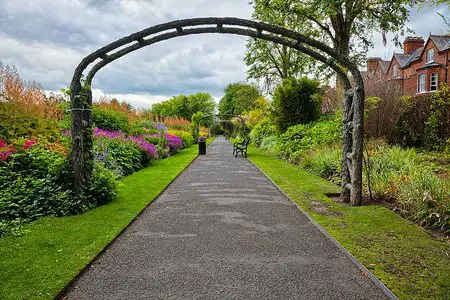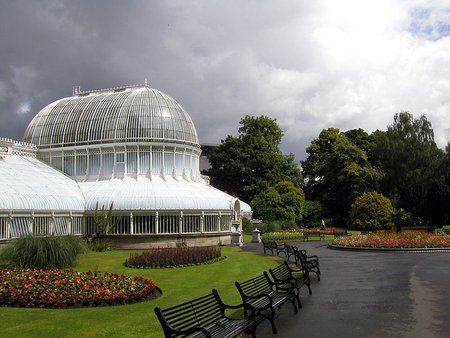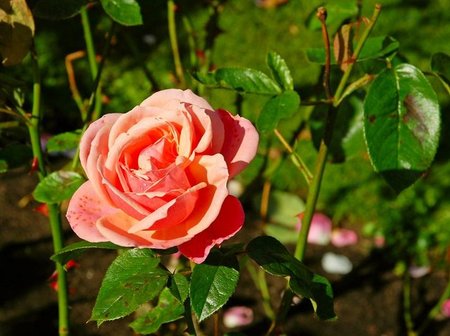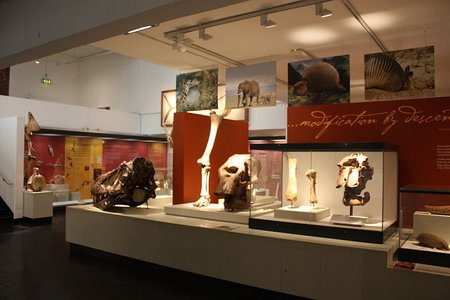Not only are the Botanical Gardens of Belfast lovely and serene; they also present a fine amalgamation of technology, artistry and old-world charm that’s hard to match. Continuing its Victorian legacy and that era’s obsession with horticulture, the gardens aim to prove that just about any species of plants can be grown anywhere provided the ‘techniques’ are right.

From 2011 to 2019, the Botanical Gardens has won the ‘Green Flag Award’ every year thereby giving it the recognition of one of the best open spaces in the UK.
The Palm House with its graceful glass and iron body is a fantastic example of how greenhouse technology can allow botanists to cultivate plants from warmer hemispheres. The Tropical Ravine is a design miracle with its rainforest and waterfalls while the rose garden is a feast of colours and the perfect place for a picnic with your special someone.
History
The Botanical gardens opened in 1828 but back then it was known as Royal Belfast Conservatory. It remained a private park for years before becoming public property in 1895 when it was taken over by Belfast Corporation. The oldest feature of the gardens is the Palm House.
Now the botanical gardens are lauded as the best managed public park of North Ireland and are an integral part of the city’s heritage. Residents, tourists and citizens often meet here to talk, picnic and relax.
Top Attractions
The main entrance of the garden on Stranmills Road has a big statue of the famous Belfast citizen Lord Kelvin. The black towering statue flanked by so many trees offers a majestic backdrop to people who have been visiting the park. Many of the trees dotting the garden are rare oaks including the Algerian Oak, Hornbeam oak and cut leaf Oak… read the signage carefully as you roam around. Most of the old and rare oaks are at the south end of the great lawn.
The Palm House Conservatory is the oldest and the most distinctive part of the Botanical gardens. The foundation of this beautifully curved iron cast glasshouse was laid way back in 1839 when Marquess of Donegall laid down the first stone. There are two wings here; tropical wing and cool wing. The Tropical wing has a lot of tall and rare tropical plants. The Australian Globe Lily, for example, is 11 meters high and is probably one of the tallest plants you will see. There is a Xanthorrhoea which is about 400 years old.

The cool wing hosts year-round displays of all colours and scents that use plants like begonia, geranium, fuchsia to create bouquets of sensations. Bot wings are 65 feet long and 20 feet high besides being 20 feet wide… the best example of Ireland’s best glasshouse designer, Richard Turner. The beautiful elliptical dome was added to create space for the tall plants to grow. The beautifully arranged hanging baskets, seasonal floral displays and birds of paradise have been charming visitors since ages.
Keeping these exotic plants healthy is tough and this is why the Palm House is whitewashed from head to toe including the 8000 window panes. The Belfast summer days are long and warm and the morning sun has a tendency to scorch which is why this annual exercise has to be done. So when you see the whitewashed pristine Palm House, think of the labour that went into whitewashing the 40 feet high dome with telescopic lance sprayers, pressure pumps etc. the whitewash is sprayed off in September so in winter you won’t see the whitewashing. Charles Lanyon designed the Palm House along with Richard Turner and the latter built the famous Great Palm House at Kew Gardens.
The Tropical Ravine House was created by erstwhile head gardener Charles Mc Kimm in 1869 and has an exceptional design. An artificially constructed ravine runs along the length of the building and there is a balcony built on both sides for visitors. The Dombeya plant that sports bloom only in February is a leading attraction. There are many flowering vines, huge tree-like ferns and plants with unusual leaf shapes.
The Tropical Ravine is known to contain some of the oldest seed plants. You will also see a good collection of orchids, cinnamon, bromeliad and banana plants. The Tropical Ravine was restored for 3.8 million pounds and its original features were preserved. This area has two levels now with an open reception area on the ground floor and triple-glazed windows that retain heat… creating the right environment for tropical plants. There are interactive and digital displays installed on booth floors for people who are interested to know more about the collections.
The Tropical Ravine has been refurbished and has been made more organised. Neat brick walls form a sort of fence around the plants and a clean path runs around the lower level… it looks like a jungle themed garden. You may or may not like the change if you have seen the garden before 2017… it had an untamed magical quality back then. Nevertheless, the climate is hot and humid and there is a distinctive rainforest feel to the place that’s a sharp contrast to Belfast cool climes. The man-made waterfall, sophisticated overhead watering system and big tank of tropical fish with big piranhas are an awesome touch and the fish is usually a big hit with the kids.
There is a Children’s Play Area that has facilities for both toddlers as well as older kids. This is an all family destination and in the summers you will find lots of people enjoying the fine weather strumming a guitar and playing outdoor games on the grass. The Botanical public house nearby provides basic refreshments and bathrooms. There are rock gardens, huge bird feeders, an alpine garden and well-defined paths for walkers.
The Herbaceous Border of the garden is said to be the longest in Ireland/ UK. The border is at its prettiest in the summers when the blooms wake up but the bamboo foliage and the lush grass are year-round attractions. 2000 sq. meters of spring shrubbery, blooms and perennials stand along a proper walkaway and is a treat to see and admire.
The circular Rose Garden was added to the park in 1932 and is one of the most beautiful parts of the Botanical Gardens. The profusion of roses in every colour and size and the patches of green grass interspersed throughout the garden make an idyllic setting for a picnic. Take along a blanket and some snacks and sit down for a casual picnic; it’s sure to create memories of a lifetime. Each bed is planted with just one kind of flower and all the beds are marked so you can read all the names of the flowers. There are a lot of Sam Mc Creedy roses in here.

If you are lucky you will be able to see an impromptu musical program on the bandstand. There are often yoga sessions held on the bandstand that’s half-hidden amongst the trees at the side of the rose garden. The Bandstand is a great place to take nice pictures and to spend a few minutes of contemplation.
Music festivals and concerts are a regular feature at the Stranmills Embankment. The Tenets ViTal musical extravaganza was held here consecutively for 4 years and famous performers including King Leon, the Coral, Streets etc performed ere. In 1997 U2 had performed here and all nearby terraces, streets and the entire garden was filled with fans. The garden has been featured in many popular novels and TV series.
The Botanical Gardens has a signage laden Walking Trail that’s a good place for nature watching and getting acquainted with its topography. Start your walk at the Lord Kelvin statue on Stranmills Road entrance and keep following the road to the right. You will pass by the Ulster Museum and the Tropical Ravine after which you need to take a left turn and then again a right turn after which you can proceed straight to the herbaceous border. Keep following the path along the top border and then turn back following the lower path until you reach a low wall with a short set of steps.
The trail now passes through the centre of the road garden and then joins the main path of the park. You can take a right turn and then a left turn to pass by the bowling green and Queen’s PEC. After this, the path goes uphill and you will pass the main lawn on your left. You will reach a three-way junction and then take the middle trail. This will take you past the palm house straight to the Stranmill road entrance that’s your finishing point. A lovely 1.3 km easy walk.
There is a new Global Medicinal Garden being developed here in partnership with Belfast City Council. Medicinal plants sourced from all corners of the world will be kept here
If walking is not your thing then simply spend some time relaxing or reading a book in one of the many wrought iron benches sitting at various points in the park. The garden is a very popular place for pre-wedding shoots and any kind of photography!!
If you turn right when you enter the garden then you will reach the Ulster Museum on the fringes of the garden (dates back to 1821) that’s a worthy attraction in itself. The exteriors are eclectic with a mixture of traditional and abstract. The displays inside the museum comprise of geology, fine art, zoology and local history apart from botany.
The Ulster Museum is the biggest museum in North Ireland and is a member of the National Museums. The finest collection of Irish natural history (bot collections and manuscripts) can be found here. History lovers must not miss the ‘Malone Hoard’ consisting of 19 polished axe heads dating back to the Neolithic era and the fantastic collection of gold jewellery from the Bronze age in the archaeology section.

If you are a lover of plants then the BEL (herbarium) will appeal to you… members of all the world’s branches of flora stay here including algae, lichens, moss, fungi, ferns and conifers. Almost all important botanists of Europe have their collections represented here.
Fashion lovers can admire the history of Irish fashion (both haute couture and high street) in the fashion and textiles section. There are collections of 18th-century silk gowns, 20th-century designer wear and collections of Vivienne Westwood, Alexander Mc Queen, Dior and Chanel.
The museum is free to visit though donations are welcome. This huge museum rightfully claims a couple of hours if you wish to explore it thoroughly.
Entry Fee
This wonderful garden and the Ulster museum has free entry apart from when there is some event. You can check the Belfast City Council’s website for schedules of upcoming events. The garden premises also has free Wi-Fi. Most of the area has easy access to wheelchairs.
Tours
You can book a free guided tour from the Belfast City Council website and the guide is usually a botanist who disburses a lot of information about the wide range of flora inside the park. You can get to know about the rare oaks and 100-year-old ferns inside and the history of Ravine and Palm Court.
The Botanical Garden is one of the top attractions of Belfast and most top city tours like the Private luxurious 8 hour Belfast sightseeing tour from Belfast Cruise Terminal offer a stop at the gardens. You can sign up for this popular Belfast tour offered by Viator.
Open Hours
Opening Time is always at 10 a.m. The best time to visit the gardens is in summer and spring because that’s when most of the plants are in bloom. In winters you will find the Palm House and Tropical Ravine very warm and comfy.
- From 28th January to 3rd February the park closes at 5 p.m. and from 4th February to 17th February, the park closes at 5.30 p.m.
- From 18th February to 3rd March the park closes at 6 p.m. and from 4th March to 17th March the park closes at 6.30 p.m.
- From 18th March to 24th March the park closes at 7 p.m. and from 25th March to 31st March the park closes at 8.00 p.m.
- From 1st April to 14th April the park closes at 8.3 p.m. and from 15th April to 25th August, the park closes at 9.00 p.m.
- From 26th August to 1st September the park closes at 8.30 p.m. and from 2nd September to 15h September the park closes at 8.00 p.m.
- From 16th September to 29th September the park closes at 7.30 p.m. and from 30th September to 13th October the park closes at 7.00 p.m.
- From 14th October to 20th October, the park closes at 6.30 p.m. and from 21st October to 27th October the park closes at 5.30 p.m.
- From 28th October to 10th November the park closes at 5 p.m. and from 11th November to 31st December the park closes at 4.30 p.m.
How To Reach
You can use the Metro to get down at Queen’s University (Metro 8) / College Park (Metro 7). Both stops are a short walk away from the Botanical gardens. There are 3 entrances of the park; Botanic Avenue, Stranmills and College Park. The Upper Queen-street bus station is 250 meters … just a 5 minute walk away while the Bruce Street Bus stop is an 11-minute walk away. The nearest Bus depot is Europa Buscenter which is a 15-minute walk away.
The Botanic Railway station is also a short walk away from the garden; this is one of the 4 major railway stations of the city and has excellent connectivity. Parking is sometimes a big issue so it is better to park on the Stranmills embankment.
College Park, Botanic Avenue, BT7 1LP; Website
Nearby Attractions & Eateries
In case you plan on visiting the Botanical gardens as well as the Ulster museum then half a day is effectively gone leaving you with not much time to explore anything else. You can wander around the historic Queen’s University campus afterwards… it is just a few minutes away. The Botanical gardens campus doesn’t have a café but there are plenty of nice restaurants outside. You can also stroll over to the Lagan Embankment for a stroll afterwards.
There is Molly’s Yard with its homely atmosphere and affordably priced Irish/ European food. The French Village Botanic on Botanic avenue is a great place for lunch. If you want to take away some food then raid the Holohan’s Pantry that’s on University Road. You can try the Irish boxty features and the inventive desserts. And if you have been sightseeing the whole day and want a nice dinner then dig into carbonara, garlic potatoes and prawns at Villa Italia before rounding things off with some Tiramisu.
 A travel addict. Still celebrating the day when he quit his high-profile corporate job to pursue his passion for travel writing.
A travel addict. Still celebrating the day when he quit his high-profile corporate job to pursue his passion for travel writing.